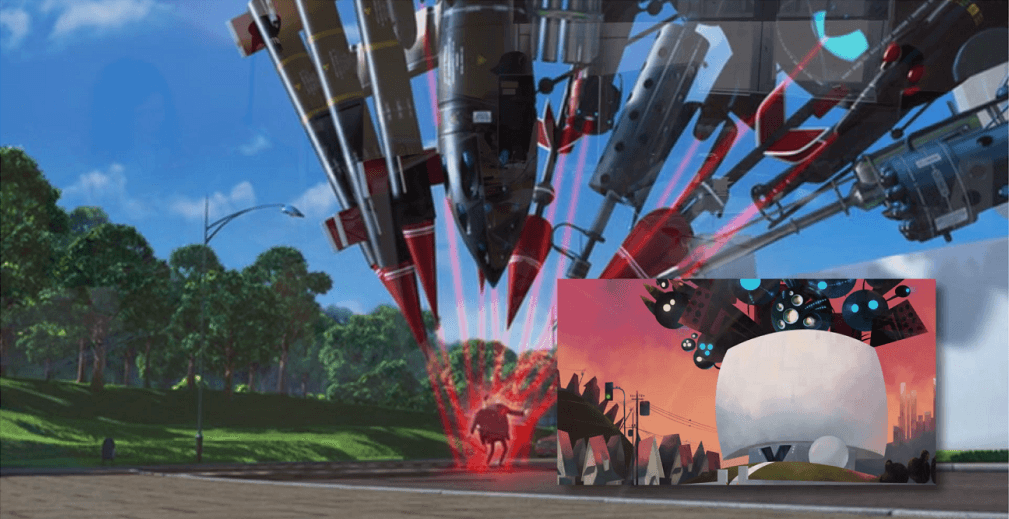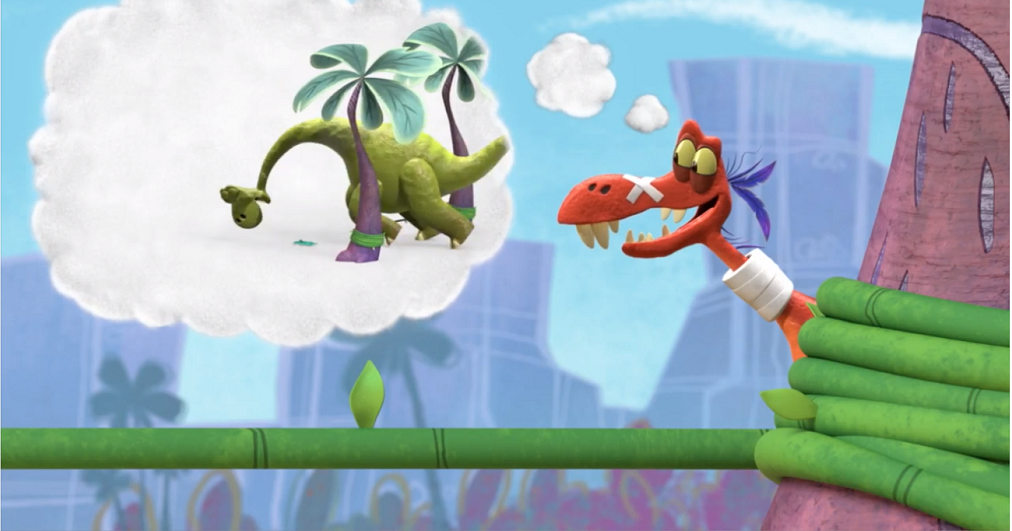For The Animation Industry, The Coronavirus Crisis Has Created A Big Opportunity
In a guest piece, producer and writer Aaron Simpson argues that animation studios are well placed to adapt to recent pandemic-driven upheavals in the entertainment sector. Simpson is a writer, producer, and development executive who has served as vice president of development at Disney Television Animation and produced shows for Warner Bros. Animation and Mondo Media, among others. He was nominated for an Emmy for producing Coconut Fred’s Fruit Salad Island, which aired on Kids’ WB. He is currently the L.A.-based creative executive for Halifax, Canada-headquartered Island of Misfits.

The coronavirus has impacted just about every aspect of our lives, and the staggering implications for the entertainment world only continue to mount. The live-action industry has seen upwards of 200,000 jobs lost worldwide and counting. The animation industry, on the other hand, has so far avoided a similar fate, with relatively few layoffs and surging demand for new content. So how did this happen? As I talked with a half-dozen studio bosses around North America, it became clear that the animation industry had been preparing for this disaster for decades without even knowing it.
Beginning in the 1960s, animated series have been regularly produced remotely, starting with Japanese studios servicing American series like The New Adventures of Pinocchio and The King Kong Show. Storyboards were shipped overseas, and then, months later, the animation takes were shipped back, resulting in a low-cost but extremely slow feedback loop.
Over the decades, technological advances have streamlined this process, resulting in literally hundreds of reliable, low-cost, all-digital studios around the world. Today’s go-to software suites like Toon Boom and Maya allow animators in Beijing and Burbank to open and edit the same asset or file. Plus, the process of reviewing a layout or an animated shot can even be done on a mobile device.
The pipeline management process has seen similar technological advances, thanks to software like Shotgun, Frame.io, Syncsketch, and Basecamp, many of which offer sophisticated analytics that allow production teams to carefully track the productivity of artists that never set foot in the studio.
New technologies, new levels of productivity
But aside from these overseas pipelines, most artists have typically worked on-site. “I would say that we had only maybe 10% of our employees and a bunch of freelancers working remotely,” said Wes Lui, co-founder and CEO of Toronto-based House of Cool Studios. That’s not to say that employees weren’t ready to quickly make the switch to a home office, as Dana Landry, CEO of Halifax-based Island of Misfits, explains: “Many of our crew members do some degree of moonlighting, and have a lot of the gear at home, which has helped us greatly.”
House of Cool studio reel.
In order to maintain productivity, many studios have adopted new technological solutions. The Halifax-based team at Copernicus Animation Studios booted up Harmony WebCC, a web server suite that allows off-site artists to tap directly into a studio’s pipeline. “It’s been a tool that we haven’t used much in the past, but now we’re using it on a large scale basis with this remote plan,” said Paul Rigg, president of Copernicus.

The negative impact on productivity has been modest, according to the studios I reached out to, while the directors at House of Cool have actually observed a higher degree of productivity. Because of the reduced amount of in-person interaction, “directors needed to be super precise about what they wanted from storyboard artists and designers, so they spent more time doing their one-on-one video conferencing during their kickoff meeting,” said Lui. After these more intensive meetings, the House of Cool animators are then, by and large, left to work uninterrupted, driving up efficiency.

Voice acting, unlike animation production, has historically been a very centralized process. Actors, producers, directors, and engineers typically get in the same room and record pages of dialog. But ever since the 1980s, studios have been able to record actors in far-off places. It all began with ISDN, a telephone-line-based system that produces remarkably high-quality sound files. This solution comes with a relatively high price tag, but in 2005, a more cost-effective, internet-based tool called Source-Connect entered the scene.
This toolset has been primarily utilized by two or more studios collaborating on a single project. But Jonathan Sherman, vice president of business development at Burbank-based Bang Zoom! Entertainment, has been finding new uses for the software with his team.
“After the stay-at-home order went into effect, we immediately focused on finding out which actors have a home setup, who doesn’t, and how can we get those people up to speed,” he said. “We then started Source-Connect training courses, testing, and onboarding voice actors who could record remotely.” The Bang Zoom! team has even recorded Source-Connect sessions with six or more actors all at once. “They can’t see each other, but they can play off each other as they would in a standard studio session,” added Sherman.
The drawbacks of remote working
But even with all these technological advances on both the recording and animation fronts, the process of producing with a fully remote team has introduced immense challenges. Studios appear to be rising to these challenges with hard work and ingenuity. “We were up and running [with a remote work setup] within a day and a half and we didn’t miss any deadlines,” said Brendan Burch, CEO of Six Point Harness in L.A. “Team members have said it was the hardest they’ve ever worked in their entire career.”
Not all artists have top-shelf setups at home, so studios have had to adapt. “Twenty to thirty percent of our crew has taken equipment home,” said Landry. The Island of Misfits team has had to step up its ability to control remote hardware, said Meaghan Clark, the studio’s head of content: “Before this crisis, only a select handful of crew members were using our remote desktop solution — we’ve had to drastically increase our usage. We’re also currently testing new software to improve and accelerate video reviews to address issues with lag and audio/picture syncing.”

Toof & Doof by Islands of Misfits.
But it’s not just hardware and software solutions that are undergoing rapid change; it’s also the workplace methods and routines that artists and producers take for granted. “I’ve shifted a lot of my attention to calling people on a personal level,” said Burch. “How’s your family? How are you getting along, are you getting into a new routine? Strangely, I’m starting to get to know some people better than I might have with them here.”
Many of the day-to-day interactions between crew members have also been upended. At Island of Misfits, “group reviews are now taking longer, and a lot of our directors and supervisors have to put more time into notes and sketches to give feedback to artists,” said Clark. “So we’re still looking at ways to improve these inefficiencies in those processes.”
Fairly straightforward studio processes, like onboarding a new team member, now bring added layers of complexity. “It’s really hard to onboard someone new,” said Burch, “because they have to get in your rhythm and that takes time. New team members learn so much from simply being in the kitchen at the same time as a director or a line producer, chatting about their project. All of that goes away. We’ll have to rethink all of how we start working with new hires.”
A new animation boom?
The net result of all of this rapid adaptation and ingenuity is an industry that’s seen very little attrition or layoffs. Brendan Burch, CEO of Six Point Harness in L.A., has the greater good in mind as he looks to the months ahead: “It’s such a helpless feeling, watching so many people lose their jobs, and we feel a civic duty to keep people working. So, early on, we committed to employing as many people as possible throughout this crisis.”
Numerous studio bosses echoed a concern not just for maintaining their staff, but for their safety as well. Vince Commisso, president and CEO of Toronto-based 9 Story Media Group, said, “We’re making sure people are safe and healthy and feel supported at this time. This is a human issue, and we’re all in the same boat.”
The full impact of this crisis on our industry remains to be seen, but it’s clear that many independent studios are considering or already implementing new processes that could prove long-lasting. The team at House of Cool is considering how the work-life balance could be improved after the pandemic. As Lui said, “The staff really likes this work-from-home system, and wants to proceed with a remote-working summertime trial. I’d be all up for it, assuming that all of our data is secure, and our deliveries have not waned.”
There’s also a high likelihood of an accelerated animation boom. “We’re hopeful that there will be more doors open on the original intellectual property front,” said Landry. “We’re anticipating that the live-action hiatus will extend for many months to come. While we empathize with our live-action comrades, this creates an opportunity for animation studios like ours that are thriving in this virtual landscape. So hopefully we’ll see broadcasters and streamers reaching out to studios like ours to see what’s ready to go, and we’ll be ready, willing, and able to greenlight two or three shows on our end.”
Others predict that this period of social distancing will bring us closer together. “Our ability to mass-communicate has been greatly enhanced,” said Commisso. “As the saying goes, necessity is the mother of invention, and we expect that, as we move forward, we’ll be able to communicate more broadly and more frequently.”
By: CARTOON BREW OP-ED

熱門頭條新聞
- Subscriptions to Free Streaming: The Platforms and Formats Redefining Entertainment
- New AI Research Foreshadows Autonomous Robotic Surgery
- Magia Exedra – More Than 400,000 Pre-Registrations Achieved!
- Mufasa: The Lion King
- Multiple measures to properly respond to AI
- 2025 Edition: Hungary, music video and an anniversary!
- SONY and Kadokawa Group have strengthened their collaboration to maximize their intellectual property
- QUByte Unveils Dark and Nostalgic Adventures for Consoles and PC
